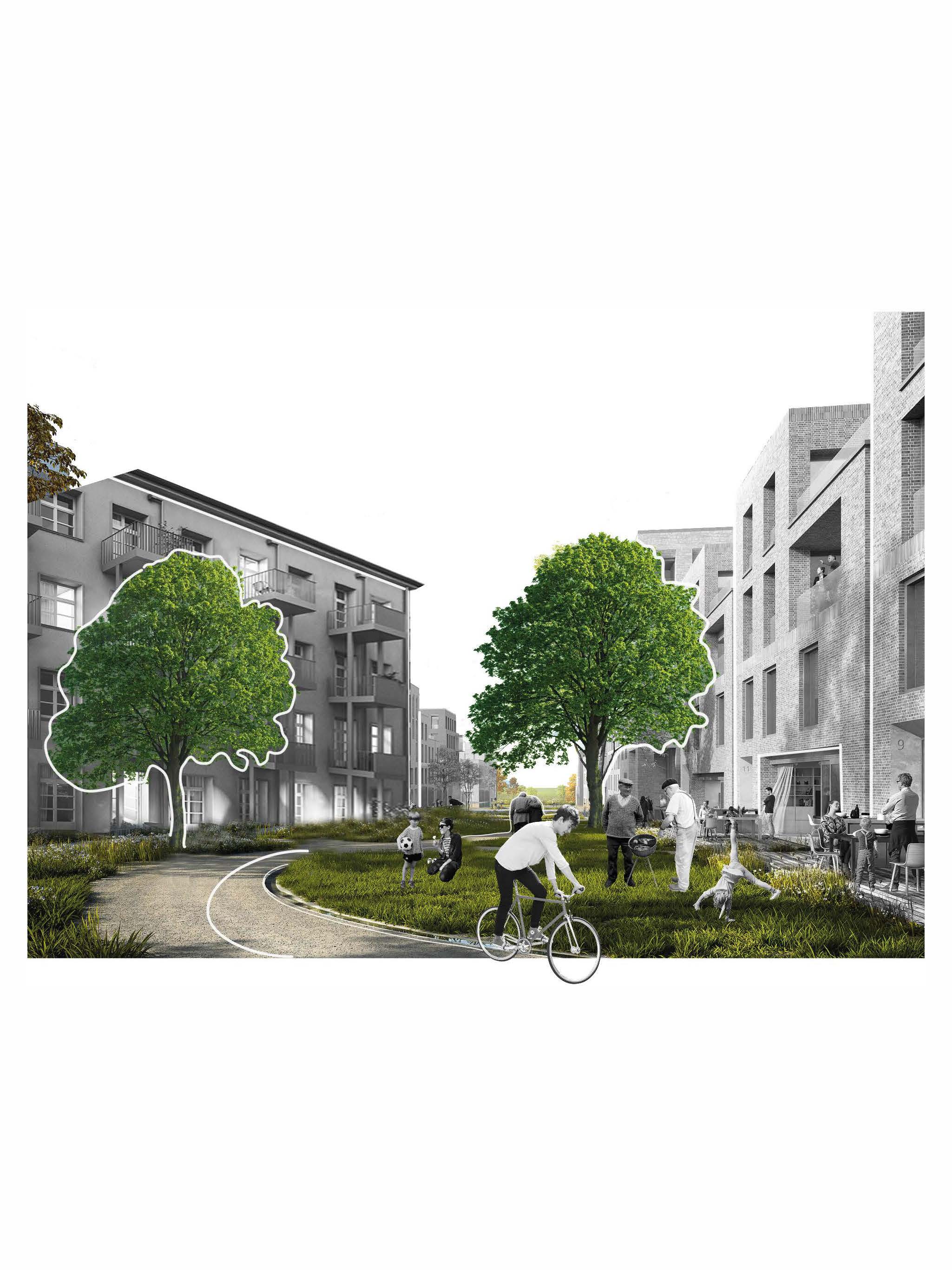Sustainable Urban Development in Munich's District 19


























































This work is dedicated to the in-depth analysis and forward-thinking conception of an urban development project in the emerging District 19 of Munich. Focused on the crucial aspect of mobility, this study explores the opportunities and challenges posed by the expected population growth. At the core is the vision of a sustainable, livable neighborhood that integrates innovative solutions for transportation, urban planning, and quality of life. The concept's implementation requires close collaboration among various stakeholders and is intended to serve as inspiration for future-oriented urban development.
Based on personal observations, research, and population forecasts, the research question arises: How can an integrated, future-proof action plan be developed for this dynamic area in the state capital of Munich, considering the planned expansion of mobility?
To thoroughly analyze the area, extensive investigations were conducted, including site visits, personal observations, literature research, and contact with potential stakeholders.
Next, the collected information was analyzed in a SWOT matrix and linked to relevant trends, resulting in identified strengths, weaknesses, opportunities, and risks. Identified weaknesses should be converted into strengths to create long-term neighborhood qualities. Strengths should be maintained and developed to prevent potential weaknesses. Opportunities should be considered to enhance and future-proof the neighborhood. The most influential trend was further examined and analyzed in relation to the selected area.
Subsequently, strengths and weaknesses as well as opportunities and risks were located. Areas with many opportunities have high development potential.
Urban development has had a significant impact on European history. European cities served diverse functions, both political and administrative, influencing art, religion, and economy, and reflecting society and its social conditions. Cities are, therefore, very sensitive social organisms in constant flux (Frey & Koch, 263).
The United Nations predicts that by 2050, approximately 70 percent of the world's population will live in urban areas. Urbanization is a significant change for humanity and, like climate change, will affect our health (Future Institute, 2020).
The state capital of Munich faces significant challenges as it belongs to the so-called "swarm cities," characterized by favorable location factors such as economic conditions, educational opportunities, and an attractive image. According to the Demography Report Part 1, there will continue to be migration to major cities, both from other regions of Germany and from abroad. The number of inhabitants in Munich is expected to exceed 1.7 million in 2029, rise to 1.8 million in 2037, and reach 1.845 million by 2040. This corresponds to a population growth of +254,500 people or +16.0 percent compared to 2019 (Demography Report Munich - Part 1).
District 19 consists of several very different neighborhoods: Thalkirchen, Obersendling, Forstenried, Fürstenried-West, and Solln. Thalkirchen, Fürstenried, Forstenried, and Solln are sought-after residential areas, thanks to their proximity to the Isar meadows and the Forstenrieder Park. These neighborhoods are particularly popular among families with children (Department of Urban Planning and Building Regulations, PLAN-HA II/33 P, 2008). Obersendling is characterized by commercial areas that extend for more than two kilometers, from the west in Drygalski-Allee to Wolfratshauser Straße in the north (Department of Urban Planning and Building Regulations, PLAN-HA II/33 P, 2008).
Obersendling is also known for Siemens AG, which relocated its headquarters from Berlin to Munich Obersendling in 1948 after World War II. This led to rapid industrial development in the district. With Siemens' relocation and the sale of the site, the area is currently undergoing restructuring, encompassing industry, offices, services, and increasingly residential buildings. In the coming years, the conversion of commercial areas will result in approximately 9,000 new residential units in District 19. This change will lead to a significant population increase. The current population forecast for the state capital of Munich expects a population growth of 16.0 percent by 2040 (Demography Report Part 2, 2021).
The majority of Munich residents are between 25 and 40 years old, an age group in which migration behavior is most pronounced due to education or employment. This group includes potential parents, and it is expected that the birth rate will increase, resulting in more children and adolescents living in the city in the future. According to Demography Report Part 2, an increase of 20% in residents aged 10 to 19 and in older people aged 60 to 74 is expected.
Both from personal observations and research and population forecasts, my research question arises: How can an integrated, future-proof action plan be developed for this dynamic area in the state capital of Munich, considering the planned expansion of mobility? With regard to the mobility transition, we will examine how the planned new buildings can be integrated with the existing public transportation system and what additional connections are necessary.
I see a significant opportunity in reducing individual car use with an attractive and intelligent public transportation offer. Due to Obersendling's favorable location and the many new construction projects, a high influx of young families is expected. The average age will decrease from 43.0 to 41.7 years.
When considering the timeline, it becomes clear that many new buildings are planned for the coming years. This includes the large residential project called Gmunder Höfe with approximately 450 apartments. At the same time, a new high school is being built on Gmunder Straße, with completion planned for 2023. By 2040, the neighborhoods of Thalkirchen, Obersendling, Forstenried, Fürstenried-West, and Solln will have 25.4% more inhabitants than in 2019, totaling 124,000 people, with the majority of population growth expected after 2030 (Demography Report Part 2, 2021).
The information and insights from the analysis were gathered and presented in the upper half of the matrix. The colored lines represent strengths, weaknesses, opportunities, and risks. Each line categorizes the framed statements not only under a SWOT category but also under the trends. It quickly becomes evident that the mobility trend is the most pronounced when considering the trends and the number of associated lines. This demonstrates that mobility plays a central role in the area's development.
In Figure 12, strengths and weaknesses, as well as opportunities and risks, are located. Areas with many opportunities have high development potential.
A summary of the analysis:From my analysis and the evaluation of the SWOT matrix, the following trends, which are particularly pronounced, emerge:
In my work, I focus on the mobility trend and apply it to a dynamic section of the commercial district. First, a concept is developed, and then the necessary interventions are illustrated.
The mobility trend proved to be one of the most significant and influential because of the expected high population influx, 25.4% by 2040, which plays a central role. For every 100 main residents in District 19, there are 39 private cars. Currently, 91,000 people live in Thalkirchen - Obersendling - Forstenried - Fürstenried - Solln, and there are approximately 35,450 private vehicles. Considering the expected population growth until 2040 of 24.5%, the number of vehicles is projected to increase to approximately 44,3625. This development will further strain the main traffic arteries and increase noise levels and CO2 emissions.
The goal is to develop a high-quality mobility concept for the area that encourages residents to refrain from or reduce individual car use. Optimizing public transportation (PT) and providing additional alternative mobility options like car sharing, bicycles, or e-scooters are of great importance.
Concept for Implementation:
To improve quality within the commercial district, several aspects are important:
To make the neighborhood attractive for the expected population growth, the following steps are necessary:
Stakeholders for Concept Implementation:
For the implementation of the concept, the following stakeholders should be involved:
Conclusion:
The analysis presented here shows that District 19 in Munich, particularly the Obersendling neighborhood, is facing significant changes. A substantial population increase is expected, bringing both opportunities and challenges.
Traffic infrastructure and mobility play a crucial role in this context. To maintain the quality of life in the neighborhood and prevent the expected increase in car traffic, it is essential to promote alternative mobility options and make public transportation more attractive.
The implementation of an integrated action plan requires the cooperation of various stakeholders, including city administration, transportation companies, real estate developers, citizens, and environmental organizations. Only through this coordinated collaboration can a sustainable and livable Obersendling be created that meets the needs of its residents.